Claude Monet
Biography
Themes in Their Work
Featured in Essays

Essay
The Wheatfield Myth: Van Gogh’s Stormiest Painting Isn’t a Suicide Note
Scroll any feed and you’ll meet this image: a blasted-blue sky, a road that forks and dies, black birds like shrapnel. The caption is almost always the same: his last canvas, his farewell. Our shiver becomes the story.

Essay
Renoir’s Sweetest Breakup
You know this image: a couple under a living arbor, hands grazing over a café table. Soft light. Soft edges. Soft story. Except the year is 1885, and Pierre‑Auguste Renoir is in crisis. The painter who helped spark Impressionism is suddenly telling friends he no longer knows how to paint. The romance on canvas hides a rupture off it.[3][10]

Essay
The Day Monet Turned a Picnic into a Comeback
Start here: a hill at Argenteuil, a flash of white dress, a boy blinking in the wind. The painting feels tossed-off and weightless. That’s the trick. Because months earlier, the money and the mood were brutal. In 1875, fresh from the first Impressionist exhibition’s ridicule, Monet and friends tried an auction at Hôtel Drouot. The crowd jeered, prices collapsed, and police were called. His name became shorthand for recklessness with paint, not value. The family’s comfort—rent, food, even paint—was on the line. The parasol wasn’t shade; it was cover. Monet needed an image that could flip the narrative: not starving bohemians, but modern life, bright and breathable, the very leisure new suburban rail lines were selling. Argenteuil was Paris’s weekend playground—sailboats, strolls, picnics, and status on display—exactly the world collectors fancied seeing on their walls.

Essay
The Cradle Was a Warning, Not a Lullaby
Paris, 1874. A young painter stakes her reputation on a domestic scene while her comrades hang boats, boulevards, and fog. Berthe Morisot chooses a nursery. Money, credibility, and a seat at the table are on the line—because if the public writes her off as merely “feminine,” she’s finished.

Essay
The Cathedral That Took Monet Hostage
The postcard version is easy: stone lace, soft color, Impressionism behaving. But Monet’s cathedral wasn’t decor. It was a duel with the sun, run on minutes and panic, with a dealer betting that the public would finally understand what Impressionism had been saying all along.

Essay
The Woman Paris Refused to See
The Salon was the only career ladder that mattered. Manet needed it. Respectability, buyers, a future—hung on a wall in 1865. Then the crowd arrived, and the painting that wouldn’t behave drew jeers so thick the museum put up a cord to protect it. The Musée d’Orsay is blunt about the reception: scandal, fury, and a guard between public and paint.

Essay
The $65 Million Spring
Christie’s, New York, 2014. Phones light up. The bidding climbs past the price of many houses, then many museums’ annual acquisitions budgets. When the hammer falls, Manet’s Jeanne (Spring) shatters a record and the Getty wins the picture for $65.1 million—a new pinnacle for the artist at auction [3][1].

Essay
The Night Degas Put the Ballerinas in the Back Row
Picture Paris in the late 1860s: velvet boxes, diamonded patrons, ballerinas floating like chandeliers. And then an unknown painter plants his easel where no one is looking—down in the orchestra pit. Why risk it? Because reputation was on the line. Degas was switching gears, ditching history painting for modern life, and the Opéra was the city’s most ruthless stage: art, money, and gossip in a single address.[1] If he chose wrong, he’d stay a nobody. He also had a personal stake. The man gripping that diagonal bassoon is Désiré Dihau—a real friend, a working musician whose salary depended on staying visible to an audience that never looked his way.[2][3] Degas knew the rules of this house, and he was about to break them on canvas.

Essay
Monet’s Quiet Bridge, Built on Noise
In 1893, Monet walked into local bureaucracy with a radical request: let me reroute a stream and build a lily pond in my backyard. Farmers objected, fearing floods and foreign plants. The painter pushed through anyway, secured permission, and set about reshaping the land at Giverny. The tranquil bridge you know was born out of paperwork and protests, not Zen stillness. [1] Money and reputation were on the line. Monet had finally bought his home in 1890 after years of financial precarity; now he was risking cash and goodwill to turn a garden into a studio—and a studio into a legacy. He wasn’t just planting; he was betting his name. He staged the scene with precision: a curved wooden span, no horizon, and a pond thick with lilies. This wasn’t picturesque chance—it was design. The bridge, lifted from the era’s mania for Japan, signaled a fashionable cool while tightening the composition like a drum. As the National Gallery in London notes, the structure arrived alongside Paris’s craze for Japanese art and prints, which Monet collected obsessively. [2] Then came the first payoff: in 1899, he painted it. If you think the image recorded a walk in the park, consider how hard he worked to make the park exist. The Japanese Footbridge compresses space, removes the sky, and turns reflection into theater, a trick he could repeat at will from his doorstep. [1] [5]

Essay
The Prettiest Sunset in Art Was Air Pollution
He arrived not for Parliament’s Gothic drama but for the weather report. From a window on the south bank, Monet lined up the towers and waited for the sky to burn through the haze. The National Gallery of Art notes he finished the canvas in 1903, after returning to Giverny to tune the color of the Thames like a violin string—then unveiled the London series in 1904, betting his mature reputation on a city that barely wanted to be seen at all. [NGA link][1]

Essay
Monet Booked the Steam
Monet was in his late thirties and still not a sure thing. The Impressionists had split with the Salon, but the public wasn’t buying in bulk. He needed a subject that felt undeniable—modern, popular, unmistakably Paris. He picked the engine room of the city itself: the Gare Saint-Lazare, the Western Railway’s iron-and-glass cathedral of departures.

Essay
Grit in the Light: Monet’s Trouville, Captured Not Just Seen
Stand before the National Gallery’s Beach at Trouville and the composition immediately leans into you: a boardwalk pulled taut on the diagonal, parasols opening like sails, and a regiment of red flags firing toward the Channel. The confection of hotels to the right—anchored by the fashionable Hôtel des Roches Noires—presses the promenade into a stage for modern leisure, a Second Empire theater of strolling and display. Monet painted it on site in the summer of 1870, a blustery day made legible by architecture and cloth rather than narrative incident, as the museum’s entry for the work recounts ([The Beach at Trouville](https://www.nationalgallery.org.uk/paintings/claude-monet-the-beach-at-trouville) [1]). [Image: Beach at Trouville (1870) — /artworks/claude-monet/beach-at-trouville] That slanted boardwalk does more than guide the eye: it sets a vector. From left surf to right-hand steps, every stroke queues to the wind’s push, a coastal physics lesson rendered in broken blues and bleached ochres.
Essay
The Wind Is the Protagonist: Monet’s Beach at Trouville as a Pre-Digital Live Feed
Beach at Trouville looks, at first glance, like a souvenir of a fashionable afternoon: sun-struck planks, white parasols, genteel promenaders. But every element is drafted into a single task—measuring the air. The diagonal boardwalk hurries the eye past the figures; a volley of red flags snaps mid-gust; skirts and veils flare into vectors. In Monet’s 1870 season at the Normandy resort, modern leisure had met meteorology—tourism built to be felt in motion [2][4]. [Artwork: /artworks/claude-monet/beach-at-trouville] That sense of motion anchors the canvas in a specific place and moment. Trouville had exploded into a Second Empire playground, its grand hotels and villas marching right up to the sand. Monet painted those very facades elsewhere that same season, including the newly fashionable Hôtel des Roches Noires—a statement of seaside modernity still rising from the dunes [1].
Featured Artworks

Haystacks Series by Claude Monet | Light, Time & Atmosphere
Claude Monet
Claude Monet’s <strong>Haystacks Series</strong> transforms a routine rural subject into an inquiry into <strong>light, time, and perception</strong>. In this sunset view, the stacks swell at the left while the sun burns through the gap, making the field shimmer with <strong>apricot, lilac, and blue</strong> vibrations.

The Artist's Garden at Giverny
Claude Monet (1900)
In The Artist's Garden at Giverny, Claude Monet turns his cultivated Clos Normand into a field of living color, where bands of violet <strong>irises</strong> surge toward a narrow, rose‑colored path. Broken, flickering strokes let greens, purples, and pinks mix optically so that light seems to tremble across the scene, while lilac‑toned tree trunks rhythmically guide the gaze inward <sup>[1]</sup><sup>[3]</sup>.
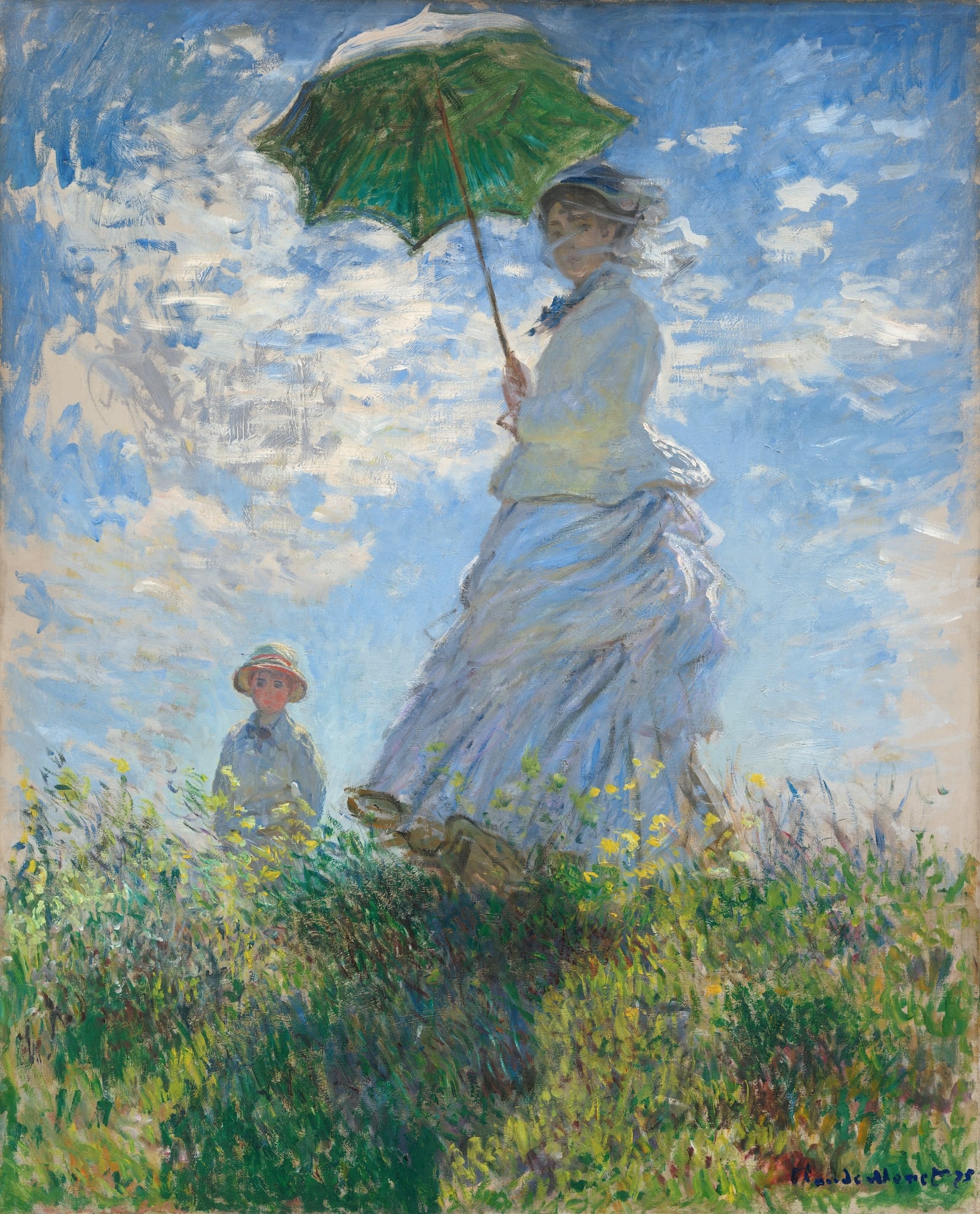
Woman with a Parasol
Claude Monet (1875)
Claude Monet’s Woman with a Parasol fixes a breezy hillside instant in high, shifting light, setting a figure beneath a <strong>green parasol</strong> against a vast, vibrating sky. The low vantage and <strong>broken brushwork</strong> merge dress, clouds, and grasses into one atmosphere, while a child at the rise anchors depth and intimacy <sup>[1]</sup>. It is a manifesto of <strong>plein-air</strong> perception—painting the sensation of air in motion rather than the contours of things <sup>[2]</sup>.
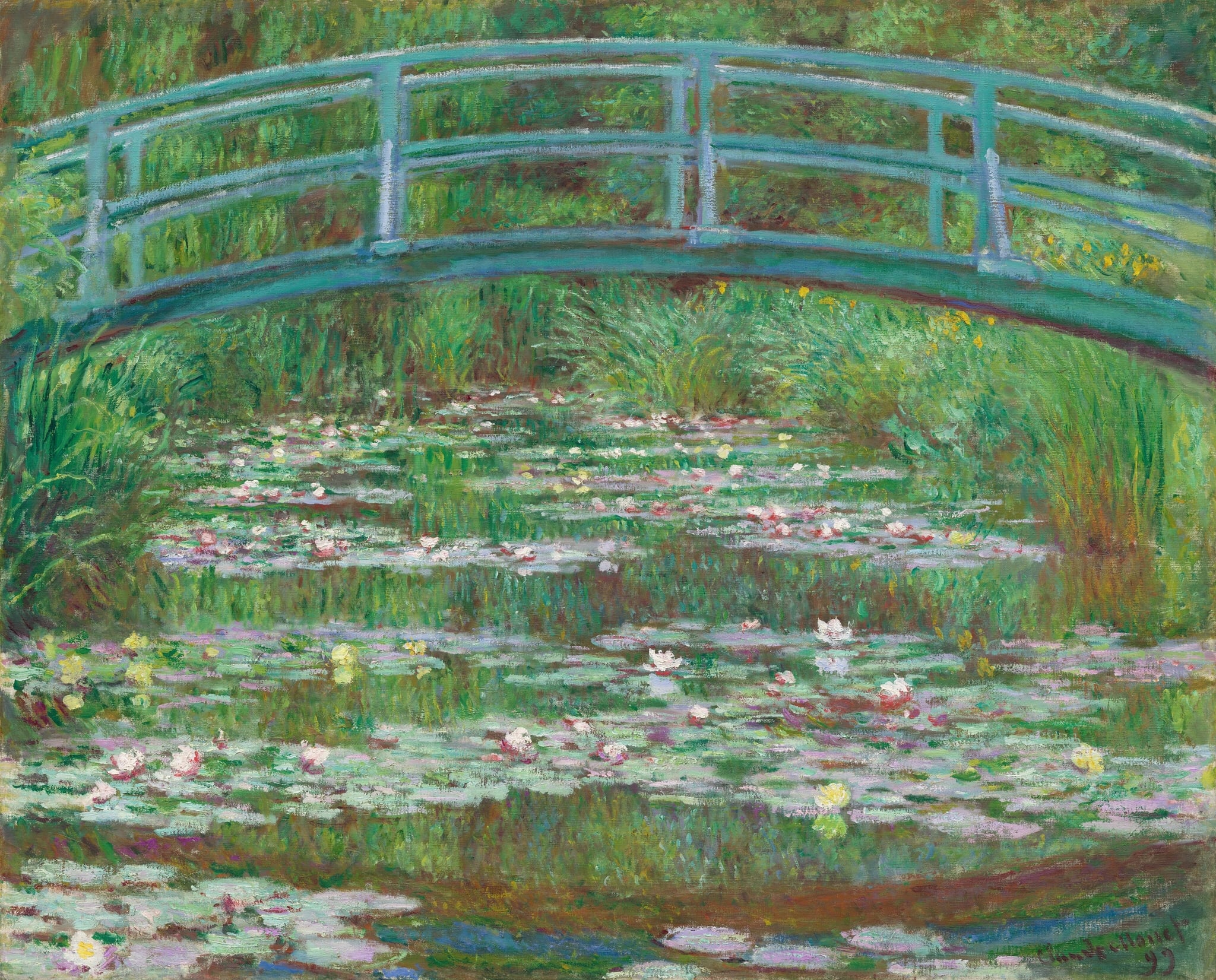
The Japanese Footbridge
Claude Monet (1899)
Claude Monet’s The Japanese Footbridge turns his Giverny garden into an <strong>immersive field of perception</strong>: a pale blue-green arc spans water crowded with lilies, while grasses and willows dissolve into vibrating greens. By eliminating the sky and anchoring the scene with the bridge, Monet makes <strong>reflection, passage, and time</strong> the picture’s true subjects <sup>[1]</sup><sup>[2]</sup>.
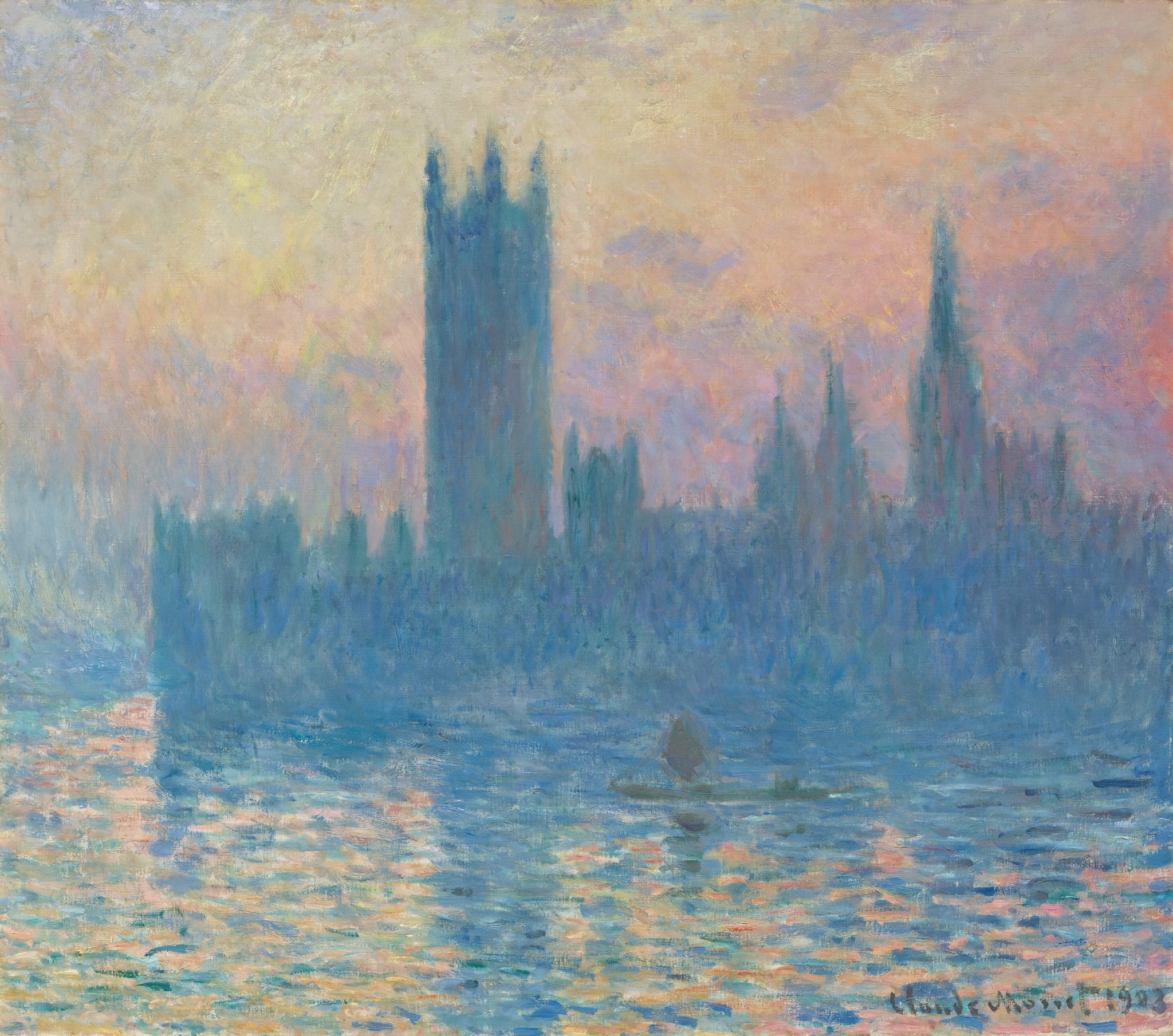
Houses of Parliament
Claude Monet (1903)
Claude Monet’s Houses of Parliament renders Westminster as a <strong>dissolving silhouette</strong> in a wash of peach, mauve, and pale gold, where stone and river are leveled by <strong>luminous fog</strong>. Short, vibrating strokes turn architecture into <strong>atmosphere</strong>, while a tiny boat anchors human scale amid the monumental scene.
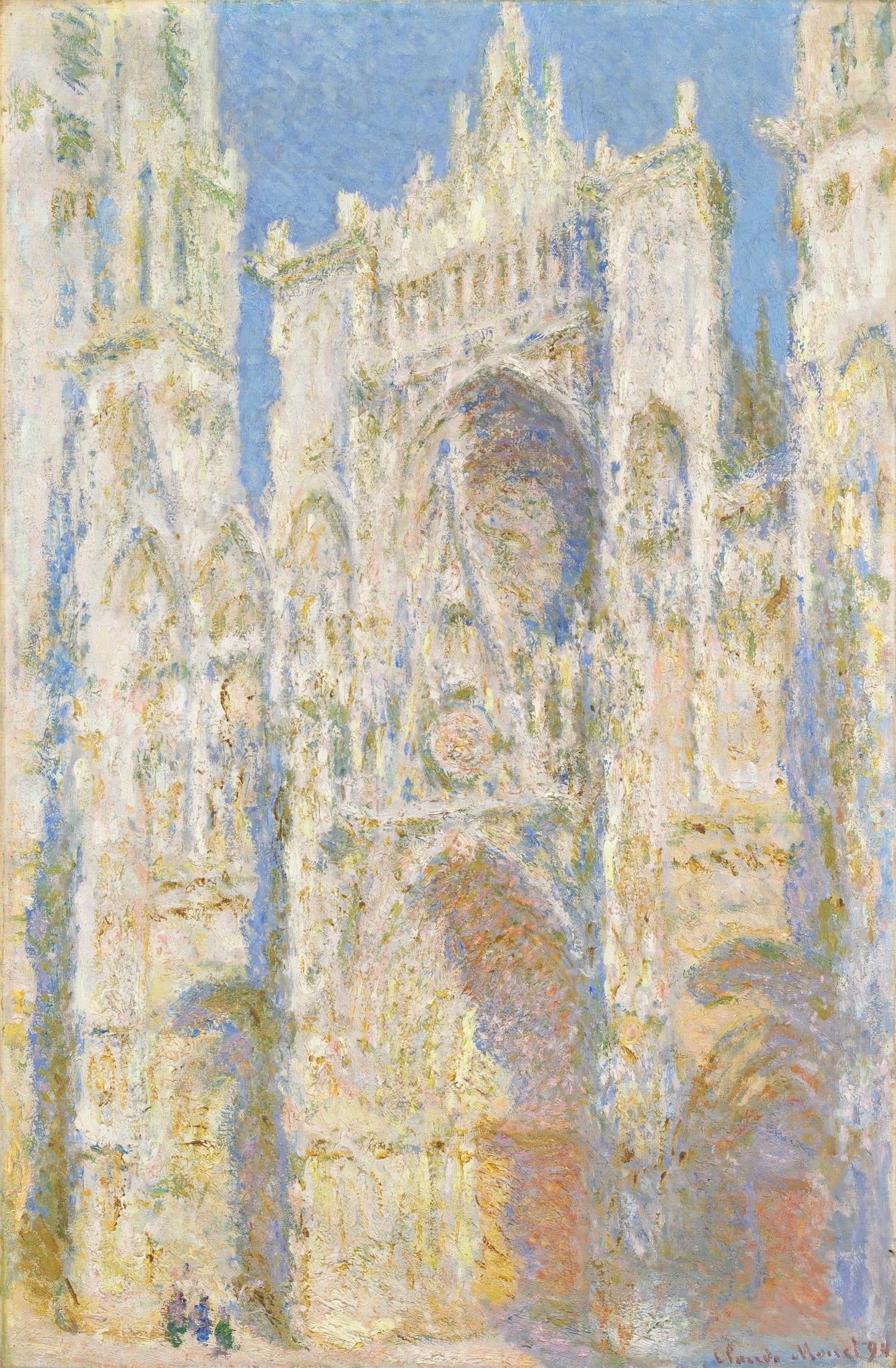
Rouen Cathedral Series
Claude Monet (1894)
Claude Monet’s Rouen Cathedral Series (1892–94) turns a Gothic monument into a laboratory of <strong>light, time, and perception</strong>. In this sunstruck façade, portals, gables, and a warm, orange-tinged rose window flicker in pearly violets and buttery yellows against a crystalline blue sky, while tiny figures at the base anchor the scale. The painting insists that <strong>light—not stone—is the true subject</strong> <sup>[1]</sup><sup>[2]</sup>.
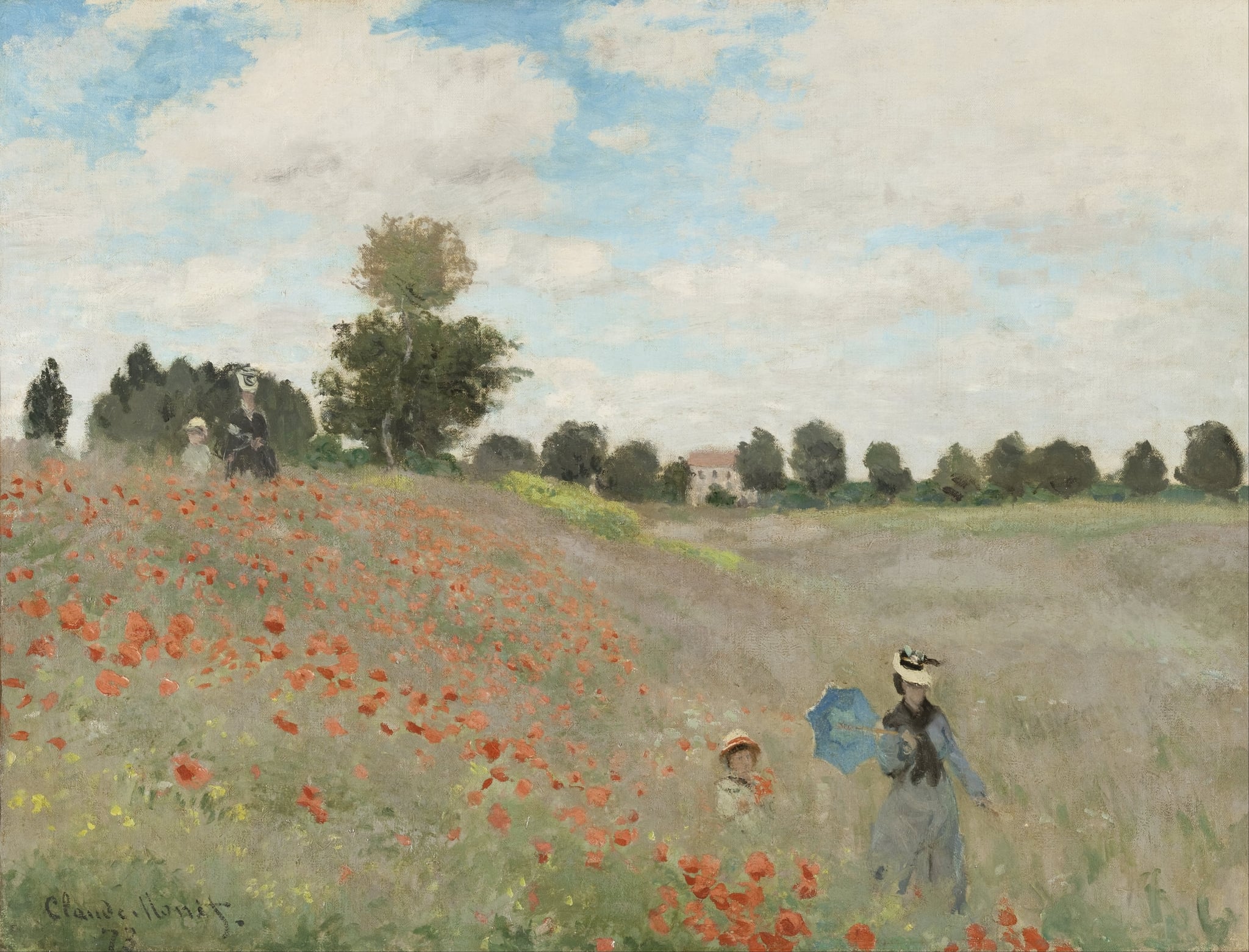
Poppies
Claude Monet (1873)
Claude Monet’s Poppies (1873) turns a suburban hillside into a theater of <strong>light, time, and modern leisure</strong>. A red diagonal of poppies counters cool fields and sky, while a woman with a <strong>blue parasol</strong> and a child appear twice along the slope, staging a gentle <strong>echo of moments</strong> rather than a single event <sup>[1]</sup>. The painting asserts sensation over contour, letting broken touches make the day itself the subject.
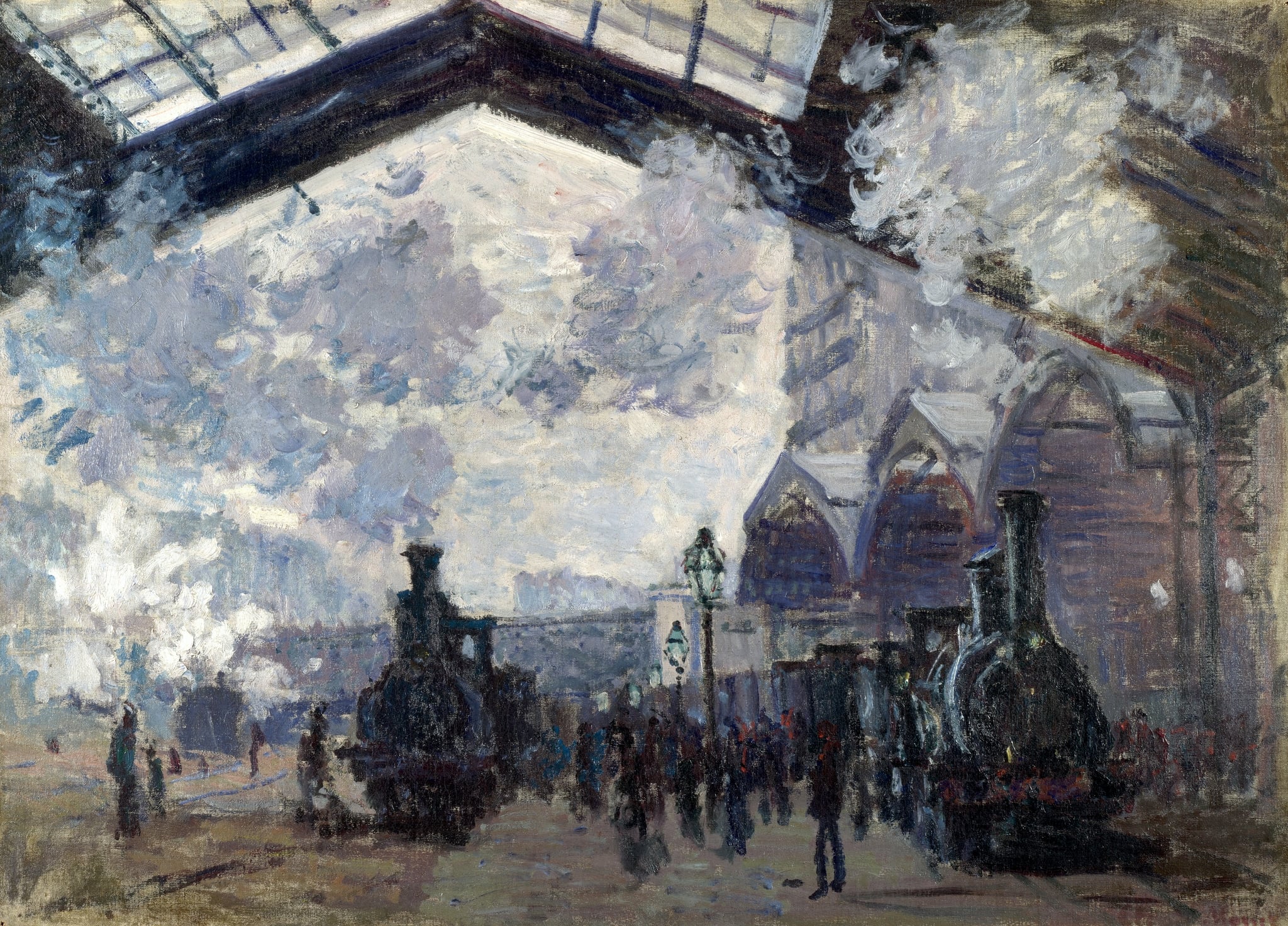
Gare Saint-Lazare
Claude Monet (1877)
Monet’s Gare Saint-Lazare turns an iron-and-glass train shed into a theater of <strong>steam, light, and motion</strong>. Twin locomotives, gas lamps, and a surge of figures dissolve into bluish vapor under the diagonal canopy, recasting industrial smoke as <strong>luminous atmosphere</strong> <sup>[1]</sup><sup>[2]</sup>.
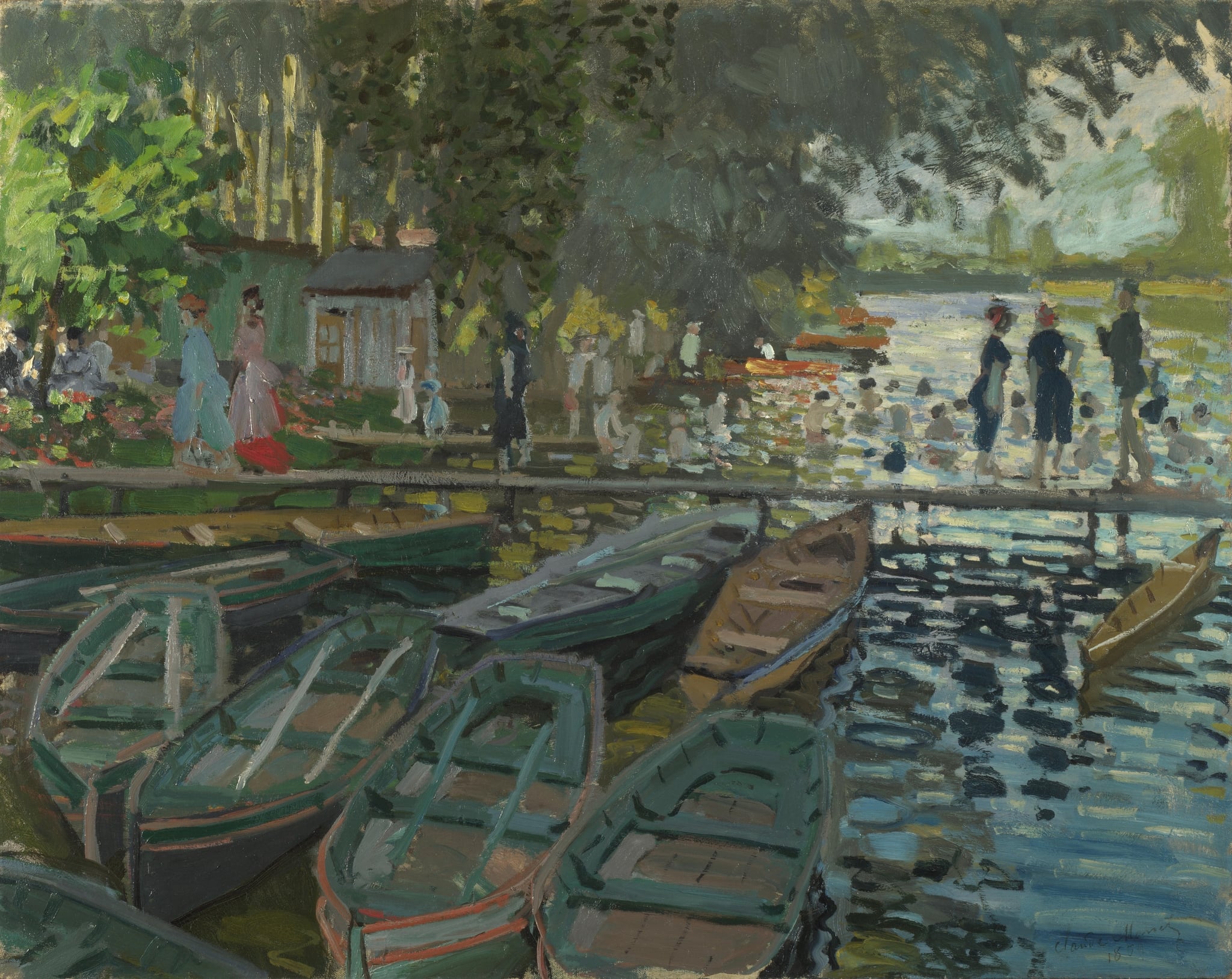
La Grenouillère
Claude Monet (1869)
Monet’s La Grenouillère crystallizes the new culture of <strong>modern leisure</strong> on the Seine: crowded bathers, promenading couples, and rental boats orbit a floating resort. With <strong>flickering brushwork</strong> and a high-key palette, Monet turns water, light, and movement into the true subjects, suspending the scene at the brink of dissolving.

Beach at Trouville
Claude Monet (1870)
Beach at Trouville turns the Normandy resort into a stage where <strong>modern leisure</strong> meets <strong>restless weather</strong>. Monet’s diagonal boardwalk, wind-whipped <strong>red flags</strong>, and white <strong>parasols</strong> marshal the eye through a day animated by light and air rather than by individual stories <sup>[1]</sup><sup>[2]</sup>. The work asserts Impressionism’s claim to immediacy—there is even <strong>sand embedded in the paint</strong> from working on site <sup>[1]</sup>.

The Magpie
Claude Monet (1868–1869)
Claude Monet’s The Magpie turns a winter field into a study of <strong>luminous perception</strong>, where blue-violet shadows articulate snow’s light. A lone <strong>magpie</strong> perched on a wooden gate punctuates the silence, anchoring a scene that balances homestead and open countryside <sup>[1]</sup>.

The Cliff Walk at Pourville
Claude Monet (1882)
Claude Monet’s The Cliff Walk at Pourville renders wind, light, and sea as interlocking forces through <strong>shimmering, broken brushwork</strong>. Two small walkers—one beneath a pink parasol—stand near the <strong>precipitous cliff edge</strong>, their presence measuring the vastness of turquoise water and bright sky dotted with white sails. The scene fuses leisure and the <strong>modern sublime</strong>, making perception itself the subject <sup>[1]</sup><sup>[2]</sup>.

San Giorgio Maggiore at Dusk
Claude Monet (1908–1912)
Claude Monet’s San Giorgio Maggiore at Dusk fuses the Benedictine church’s dark silhouette with a sky flaming from apricot to cobalt, turning architecture into atmosphere. The campanile’s vertical and its wavering reflection anchor a sea of trembling color, staging a meditation on <strong>permanence</strong> and <strong>flux</strong>.

Regatta at Sainte-Adresse
Claude Monet (1867)
On a brilliant afternoon at the Normandy coast, a diagonal <strong>pebble beach</strong> funnels spectators with parasols toward a bay scattered with <strong>white-sailed yachts</strong>. Monet’s quick, broken strokes set <strong>wind, water, and light</strong> in synchrony, turning a local regatta into a modern scene of leisure held against the vastness of sea and sky <sup>[1]</sup><sup>[2]</sup>.

The Artist's Garden at Vétheuil
Claude Monet (1881)
Claude Monet’s The Artist’s Garden at Vétheuil stages a sunlit ascent through a corridor of towering sunflowers toward a modest house, where everyday life meets cultivated nature. Quick, broken strokes make leaves and shadows tremble, asserting <strong>light</strong> and <strong>painterly surface</strong> over linear contour. Blue‑and‑white <strong>jardinieres</strong> anchor the foreground, while a child and dog briefly pause on the path, turning the garden into a <strong>domestic sanctuary</strong> <sup>[1]</sup><sup>[2]</sup>.

Camille (The Woman in the Green Dress)
Claude Monet (1866)
Monet’s Camille (The Woman in the Green Dress) turns a full-length portrait into a study of <strong>modern spectacle</strong>. The spotlit emerald-and-black skirt, set against a near-black curtain, makes <strong>fashion</strong> the engine of meaning and the vehicle of status.

Snow at Argenteuil
Claude Monet (1875)
<strong>Snow at Argenteuil</strong> renders a winter boulevard where light overtakes solid form, turning snow into a luminous field of blues, violets, and pearly pinks. Reddish cart ruts pull the eye toward a faint church spire as small, blue-gray figures persist through the hush. Monet elevates atmosphere to the scene’s <strong>protagonist</strong>, making everyday passage a meditation on time and change <sup>[1]</sup><sup>[2]</sup>.

The Beach at Sainte-Adresse
Claude Monet (1867)
In The Beach at Sainte-Adresse, Claude Monet stages a modern shore where <strong>labor and leisure intersect</strong> under a broad, changeable sky. The bright <strong>blue beached boat</strong> and the flotilla of <strong>rust-brown working sails</strong> punctuate a turquoise channel, while a fashionably dressed pair sits mid-beach, spectators to the traffic of the port. Monet’s brisk, broken strokes make the scene feel <strong>caught between tides and weather</strong>, a momentary balance of work, tourism, and atmosphere <sup>[1]</sup><sup>[2]</sup>.